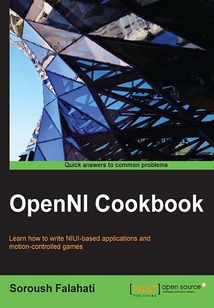舉報 

會員
OpenNI Cookbook
最新章節:
Index
ThisisaCookbookwithplentyofpracticalrecipesenrichedwithexplainedcodeandrelevantscreenshotstoeaseyourlearningcurve.IfyouareabeginneroraprofessionalinNIUIandwanttowriteseriousapplicationsorgames,thenthisbookisforyou.EvenOpenNI1andOpenNI1.xprogrammerswhowanttomovetonewversionsofOpenNIcanusethisbookasastartingpoint.ThisbookusesC++astheprimarylanguagebuttherearesomeexamplesinC#andJavatoo,soyouneedtohaveaboutabasicworkingknowledgeofCorC++formostcases.
目錄(60章)
倒序
- 封面
- 版權信息
- Credits
- About the Author
- About the Reviewers
- www.PacktPub.com
- Preface
- Chapter 1. Getting Started
- Introduction
- Downloading and installing OpenNI
- Downloading and installing NiTE
- Downloading and installing the Microsoft Kinect SDK
- Connecting Asus Xtion and PrimeSense sensors
- Connecting Microsoft Kinect
- Chapter 2. OpenNI and C++
- Introduction
- Creating a project in Visual Studio 2010
- OpenNI class and error handling
- Enumerating a list of connected devices
- Accessing video streams (depth/IR/RGB) and configuring them
- Retrieving a list of supported video modes for depth stream
- Selecting a specific device for accessing depth stream
- Listening to the device connect and disconnect events
- Opening an already recorded file (ONI file) instead of a device
- Chapter 3. Using Low-level Data
- Introduction
- Configuring Visual Studio 2010 to use OpenGL
- Initializing and preparing OpenGL
- Reading and showing a frame from the image sensor (color/IR)
- Reading and showing a frame from the depth sensor
- Controlling the player when opening a device from file
- Recording streams to file (ONI file)
- Event-based reading of data
- Chapter 4. More about Low-level Outputs
- Introduction
- Cropping and mirroring frames right from the buffer
- Syncing image and depth sensors to read new frames from both streams at the same time
- Overlaying the depth frame over the image frame
- Converting the depth unit to millimetre
- Retrieving the color of the nearest point without depth over color registration
- Enabling/disabling auto exposure and auto white balance
- Chapter 5. NiTE and User Tracking
- Introduction
- Getting a list of all the active users
- Identifying and coloring users' pixels in depth map
- Reading users' bounding boxes and center of mass
- Event-based reading of users' data
- Chapter 6. NiTE and Hand Tracking
- Introduction
- Recognizing predefined hand gestures
- Tracking hands
- Finding the related user ID for each hand ID
- Event-based reading of hands' data
- Working sample for controlling the mouse by hand
- Chapter 7. NiTE and Skeleton Tracking
- Introduction
- Detecting a user's pose
- Getting a user's skeleton joints and displaying their position in the depth map
- Designing a simple pong game using skeleton tracking
- Index 更新時間:2021-08-13 16:30:28
推薦閱讀
- 現代C++編程:從入門到實踐
- Python 3.7網絡爬蟲快速入門
- LabVIEW 2018 虛擬儀器程序設計
- R語言數據可視化實戰
- C++ 從入門到項目實踐(超值版)
- Android Native Development Kit Cookbook
- Learning Laravel's Eloquent
- Angular開發入門與實戰
- Programming with CodeIgniterMVC
- Go語言編程
- 算法圖解
- Software Architecture with Python
- Python趣味創意編程
- Java EE互聯網輕量級框架整合開發:SSM+Redis+Spring微服務(上下冊)
- 深入理解Android:WebKit卷
- Java入門經典
- 數據結構案例教程:C語言版
- JSP程序設計實訓與案例教程(第2版)
- 高并發系統:設計原理與實踐
- Android設計模式與最佳實踐
- Java程序員職場全攻略
- 計算機文化基礎
- AWS Administration:The Definitive Guide
- 數據庫技術及應用教程(第2版)
- Visual Basic程序設計實驗指導
- Java 9 Regular Expressions
- Expert Delphi
- Kali Linux Cookbook(Second Edition)
- Android開發寶典
- 微信小程序開發從零開始學

